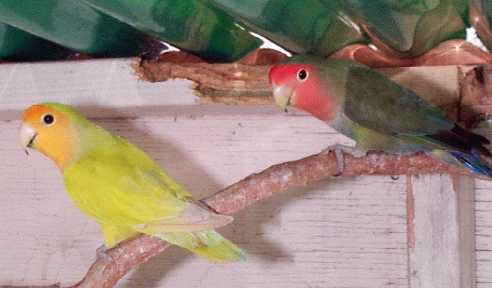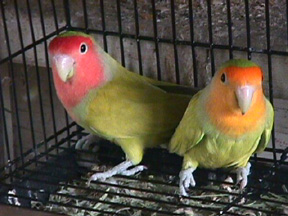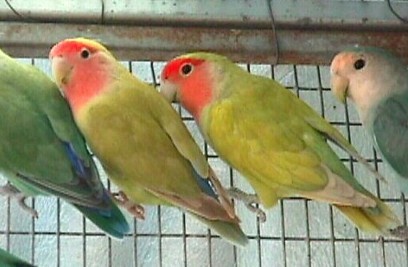
Tango (on the left) is an
Orangefaced American Yellow (or if you want to get confusing, she is
an Orangeface Cherryhead Peachface!) Her mate, Reggae (on the right)
is a jade violet. You can see the violet-blue tint on his underside
in this picture.)
Tango (above) is an Orangeface
American Yellow. The American Yellow is also called a Cherryhead, or
Golden Cherry, or "Pastel Spangles" (in Europe.). They are most
easily identified by the greyish "penciling" on the edge of the
feathers. But the penciling is not very clear in some of these
pictures. You can see it best in the one with the mother and two
young ones further down the page.
Some have described them as "a
lutino that fell down the chimney and is covered in soot." But their
body color is not as yellow as a lutino -- they are more a
greenish-yellow with a slight grey cast to them.

You will notice that a normal
Cherryhead (above) has the red face of a normal peachface. Rhumba
(next to her), however, has the orangeface factor (evident in his
forehead color).

And a mom and two 8-week-old
babies. Notice the dark part on their beak is more brown than black
as it would be in most peachface mutations. Here also, you can see
the penciling better.

And a young orangeface American
yellow with a double dark factor. You can see here how the dark
factor increases the "penciling" on the feathers -- not just in
value, but in width.
Another identifying factor on the American
Yellow is the unusual rump. Instead of the solid blue feathers you'd
see on most peachfaces, this mutation has a blue rump that looks as
though it was painted on with a half-dry paintbrush, giving it an
etched-on appearance. Below are some pictures to illustrate
this.


The bird on the right also has a dark factor.
You can see this in the rump feathers which are a deeper blue, and it
is hard to tell, but the edges of the body and wing feathers have
darker (and thicker) edging than bird one on the left.
An American Yellow that is in
the blue series is called a silver.
You can see
a
silver by clicking
here.
Below is a picture comparing an
American Yellow and an American Cinnamon -- two birds that are easily
confused by those who are not familiar with these two
mutations.

At first glance, very similar.
The differences?
First: The cinnamon (on the
left) has a bit more of an olive tinge to its overall body color, and
a consistent coloring throughout pretty much. The American yellow
(right) is slightly more yellow with grey "penciling" on feather
edges, giving it a a bit of a grey tinge (as though the bird was
wrapped in newsprint when it was wet!)
Second: Notice the flights. The
Cinnamon's (left) are darker cinnamon brown, while the Yellow's are
more a silvery-grey with a slight edging of darker
grey.
Third: The rump. The cinnamon
(left) has a solid blue rump. The Yellow has the "etched on" coloring
described above.
Fourth: The cinnamon's feet
will be more pinkish, while the feet of the Yellow will be
grey.